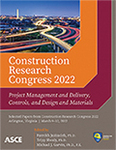Forecasting Architecture Billings Index Using Time Series Models
Publication: Construction Research Congress 2022
ABSTRACT
The construction market presents volatile fluctuations through time. These fluctuations are problematic for project planners and decision-makers to accurately assess business conditions and develop business outlooks. Therefore, it is necessary to forecast the market trends and fluctuations as accurately as possible for planning construction projects, allocating resources, and formulating strategies. Practitioners refer to Architecture Billings Index (ABI) as a leading indicator in the construction market. ABI forecasting can assist project planners in tracking construction market fluctuations to properly allocate resources and identify business opportunities. The main objective of this research is to develop time series models for forecasting ABI. The historical ABI data are used to develop the univariate time series models and validate their forecasting performance. The results show that the seasonal autoregressive integrated moving average (Seasonal ARIMA) model provides the most accurate out-of-sample forecasts. The findings of this research can assist project planners and decision-makers in forecasting volatile fluctuations in the construction market for project planning and strategic decision-making.
Get full access to this article
View all available purchase options and get full access to this chapter.
REFERENCES
Abediniangerabi, B., Ahmadi, N., and Shahandashti, M. (2018). Is Architectural Billing Index Helpful to Explain Fluctuations in Non-residential Construction Spending in the United States?. In Construction Research Congress (pp. 19–28).
Abediniangerabi, B., Shahandashti, S. M., Ahmadi, N., and Ashuri, B. (2017). Empirical investigation of temporal association between architecture billings index and construction spending using time-series methods. Journal of Construction Engineering and Management, 143(10), 04017080.
Ashuri, B., and Lu, J. (2010). Time series analysis of ENR construction cost index. Journal of Construction Engineering and Management, 136(11), 1227–1237.
Baker, K., Aia, H., Chu, J., and Riskus, J. (2014). Designing the construction future: Reviewing the performance and extending the applications of the AIA’s architecture billings index.
Baker, K., and Saltes, D. (2005). Architecture billings as a leading indicator of construction. Business Economics, 40(4), 67–73.
Bhattacharyya, A., Yoon, S., Weidner, T. J., and Hastak, M. (2021). Purdue Index for Construction Analytics: Prediction and Forecasting Model Development. Journal of Management in Engineering, 37(5), 04021052.
Brockwell, P. J., and Davis, R. A. (2016). Introduction to time series and predicting. springer.
Choi, C. Y., Ryu, K. R., and Shahandashti, M. (2021). Predicting City-Level Construction Cost Index Using Linear Forecasting Models. Journal of Construction Engineering and Management, 147(2), 04020158.
Enders, W. (2012). Applied econometric time series. Privredna kretanja i ekonomska politika, 132, 93.
Faghih, S. A. M., and Kashani, H. (2018). Forecasting construction material prices using vector error correction model. Journal of construction engineering and management, 144(8), 04018075.
Finkel, G. (2015). The economics of the construction industry. Routledge.
FMI (Fails Management Institute). (2021). “2021 Engineering and Construction Industry Overview: United States.” 〈https://www.fminet.com/outlook/us-outlook-first-quarter-2021-report/〉.
Hyndman, R. J., and Athanasopoulos, G. (2018). Forecasting: principles and practice. OTexts.
Ilbeigi, M., Ashuri, B., and Joukar, A. (2017). Time series analysis for forecasting asphalt-cement price. Journal of Management in Engineering, 33(1), 04016030.
Karaca, I., Gransberg, D. D., and Jeong, H. D. (2020). Improving the accuracy of early cost estimates on transportation infrastructure projects. Journal of Management in Engineering, 36(5), 04020063.
Kim, S., Abediniangerabi, B., and Shahandashti, M. (2020). Predicting Pipeline Construction Costs Using Time Series Methods. In Pipelines 2020 (pp. 198–209). Reston, VA: American Society of Civil Engineers.
Kim, S., Abediniangerabi, B., and Shahandashti, M. (2021a). Pipeline Construction Cost Predicting Using Multivariate Time Series Methods. Journal of Pipeline Systems Engineering and Practice, 12(3), 04021026.
Kim, S., Abediniangerabi, B., and Shahandashti, M. (2021b) Forecasting Pipeline Construction Costs Using Recurrent Neural Networks. In Pipelines 2021 (pp. 325–335).
Lam, K. C., and Oshodi, O. S. (2016). Forecasting construction output: a comparison of artificial neural network and Box-Jenkins model. Engineering, Construction and Architectural Management.
Li, M., Baek, M., and Ashuri, B. (2021). Forecasting Ratio of Low Bid to Owner’s Estimate for Highway Construction. Journal of Construction Engineering and Management, 147(1), 04020157.
Lima, S., Gonçalves, A. M., and Costa, M. (2019, December). Time series forecasting using Holt-Winters exponential smoothing: An application to economic data. In AIP Conference Proceedings (Vol. 2186, No. 1, p. 090003). AIP Publishing LLC.
Millar, J. N., Oliner, S. D., and Sichel, D. E. (2016). Time-to-plan lags for commercial construction projects. Regional Science and Urban Economics, 59, 75–89.
Moon, T., and Shin, D. T. (2018). Forecasting construction cost index using interrupted time-series. KSCE Journal of Civil Engineering, 22(5), 1626–1633.
Oshodi, O. S., Ejohwomu, O. A., Famakin, I. O., and Cortez, P. (2017). Comparing univariate techniques for tender price index forecasting: Box-Jenkins and neural network model. Construction Economics and Building, 17(3), 109–123.
Shahandashti, S. M., and Ashuri, B. (2013). Forecasting engineering news-record construction cost index using multivariate time series models. Journal of Construction Engineering and Management, 139(9), 1237–1243.
Shahandashti, S. M. (2014). Analysis of construction cost variations using macroeconomic, energy and construction market variables (Doctoral dissertation, Georgia Institute of Technology).
Shahandashti, S. M., and Ashuri, B. (2016). Highway construction cost forecasting using vector error correction models. Journal of management in engineering, 32(2), 04015040.
Shahandashti, M., Ashuri, B., and Mostaan, K. (2018). Automatic fault detection for Building Integrated Photovoltaic (BIPV) systems using time series methods. Built Environment Project and Asset Management.
Yip, H. L., Fan, H., and Chiang, Y. H. (2014). Predicting the maintenance cost of construction equipment: Comparison between general regression neural network and Box–Jenkins time series models. Automation in Construction, 38, 30–38.
Information & Authors
Information
Published In
History
Published online: Mar 7, 2022
Authors
Metrics & Citations
Metrics
Citations
Download citation
If you have the appropriate software installed, you can download article citation data to the citation manager of your choice. Simply select your manager software from the list below and click Download.
